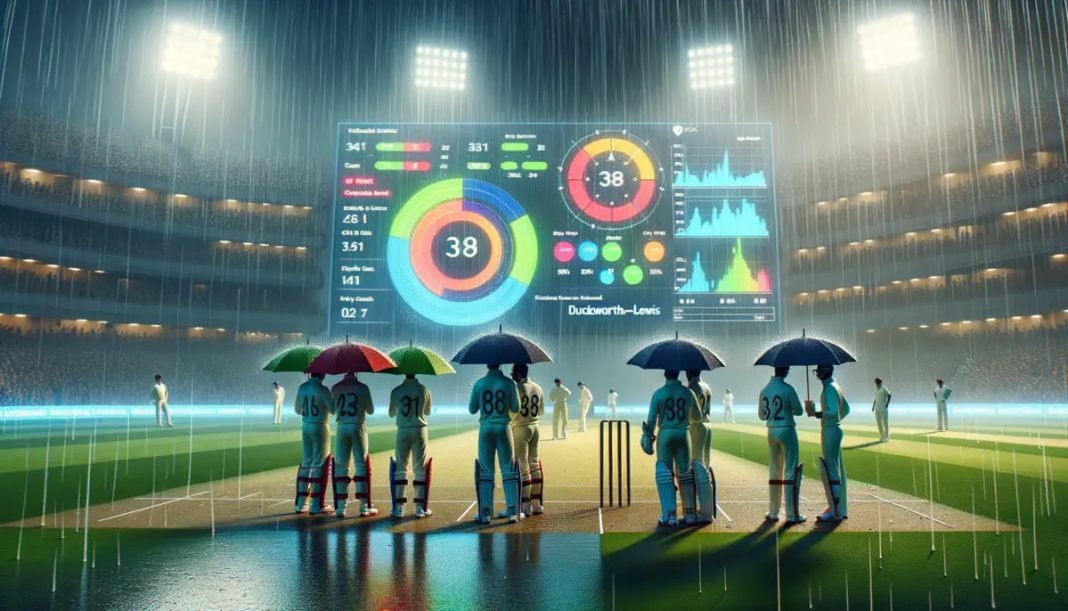Cricket, the “gentleman’s game,” is no stranger to the vagaries of weather. Rain disruptions, a constant threat, can significantly impact the outcome of a match, leaving fans disappointed and raising questions about fairness. However, the introduction of the Duckworth-Lewis (D/L) method has revolutionized the way rain-affected matches are handled, striving to ensure a fair and balanced contest even in the face of unpredictable weather interruptions.
Pre-D/L: A System Fraught With Flaws
Prior to the D/L method, determining a revised target in rain-affected matches was a complex and subjective process. The Average Run Rate (ARR) method was initially used, simply calculating the required run rate for the team batting second based on the overs remaining and the score of the team batting first. This method, however, did not account for wickets lost, making it unfair to the team chasing a lower total. And in the dynamic world of the purple cap in ipl 2024 stands as a symbol of bowling excellence. Yet, amid rain disruptions, ensuring fair play becomes paramount. With stringent regulations and innovative strategies, IPL organizers strive to maintain the integrity of matches, allowing bowlers to showcase their prowess and compete for the coveted Purple Cap.
Another method, the Most Productive Overs (MPO) method, considered only the best overs of the team batting first, further disadvantageous to the team chasing a smaller total. These methods were often criticized for producing unrealistic and sometimes unfair revised targets, leading to frustration and controversy.
The D/L Method: A Paradigm Shift
In 1999, the Duckworth-Lewis method, developed by statisticians Frank Duckworth and Tony Lewis, was introduced as a more statistically sound and objective approach. This method takes into account several crucial factors:
- Overs lost: This is the most critical factor, as it determines the amount of time remaining for the team batting second to chase the target.
- Wickets lost: The D/L method recognizes the importance of wickets in cricket, as losing wickets slows down run scoring.
- The par score: This is the theoretical score the team batting second would have achieved had the match not been interrupted, based on historical data and mathematical calculations.
The D/L method uses a complex algorithm to calculate a revised target, considering all these factors. This ensures a fair and balanced contest, as both teams have a statistically equal chance of winning based on the resources available (overs remaining and wickets in hand).
Impact Of The D/L Method
The D/L method has had a significant impact on cricket in several ways:
- Promotes Fair Play: By considering all relevant factors, the D/L method ensures a more balanced contest, reducing the element of unfairness previously associated with rain-affected matches. This has enhanced the integrity of the game.An accurate ipl prediction are crucial, especially in rain-affected matches. With evolving weather patterns, ensuring fair play becomes imperative. Through advanced technology and strategic planning, IPL organizers aim to maintain match integrity, providing fans with reliable predictions while safeguarding the spirit of the game.
- Strategic Decision-Making: The D/L method encourages teams to be more strategic, especially when chasing a target. Teams need to analyze the revised target and the D/L par score to determine the required run rate and plan their innings accordingly.
- Increased Excitement: The D/L method often leads to thrilling finishes, as teams chase revised targets under pressure. This adds to the excitement and unpredictability of rain-affected matches, keeping fans engaged until the very last ball.
Challenges And Limitations
While the D/L method has been a significant improvement, it still faces some challenges:
- Complexity and Transparency: The D/L calculations are complex and often not readily understood by fans. The need for greater transparency regarding the calculations and the reasoning behind revised targets remains crucial.
- Unforeseen Events: The D/L method cannot account for unforeseeable events such as sudden changes in weather conditions or exceptional individual performances, which can still influence the outcome of a match.
- Contentious Outcomes: Despite being objective, the D/L method can sometimes lead to controversial outcomes, particularly in close matches. This highlights the need for continuous refinement and improvement of the system.
The Future Of The D/L Method
The D/L method is constantly evolving, with refinements being made to address its limitations. The use of advanced statistical analysis and machine learning is being explored to further improve the accuracy of revised targets and increase transparency. Stay ahead of the game with indibet, your ultimate IPL companion. From live updates to expert analysis, Indibet keeps you informed and engaged throughout the IPL season. With cutting-edge features and real-time insights, it’s your go-to platform for staying one step ahead and making informed decisions. Overall, the D/L method has undoubtedly played a crucial role in ensuring fair play and maintaining the integrity of cricket in the face of rain disruptions. While challenges remain, continuous improvements and ongoing discussions regarding its implementation will ensure that the game remains fair, exciting, and enjoyable for fans and players alike.
Conclusion
The Duckworth-Lewis method has revolutionized rain-affected cricket, transforming what was once a frustrating and subjective process into a more objective and statistically sound approach. By considering crucial factors like overs lost, wickets lost, and historical data, the D/L method attempts to create a fair playing field for both teams, regardless of weather interruptions.
While the method faces challenges regarding complexity, unforeseen events, and occasional controversies, its impact on promoting fair play, encouraging strategic decision-making, and enhancing the thrill of rain-affected matches is undeniable. As the D/L method continues to evolve through further refinement and technological advancements, it remains a vital tool for ensuring the integrity and excitement of cricket in the face of the ever-present threat of rain. The future of this method lies in ongoing dialogue, transparent communication, and continuous improvement, ensuring that the spirit of fair play continues to reign supreme even amidst the unpredictable nature of the weather.






